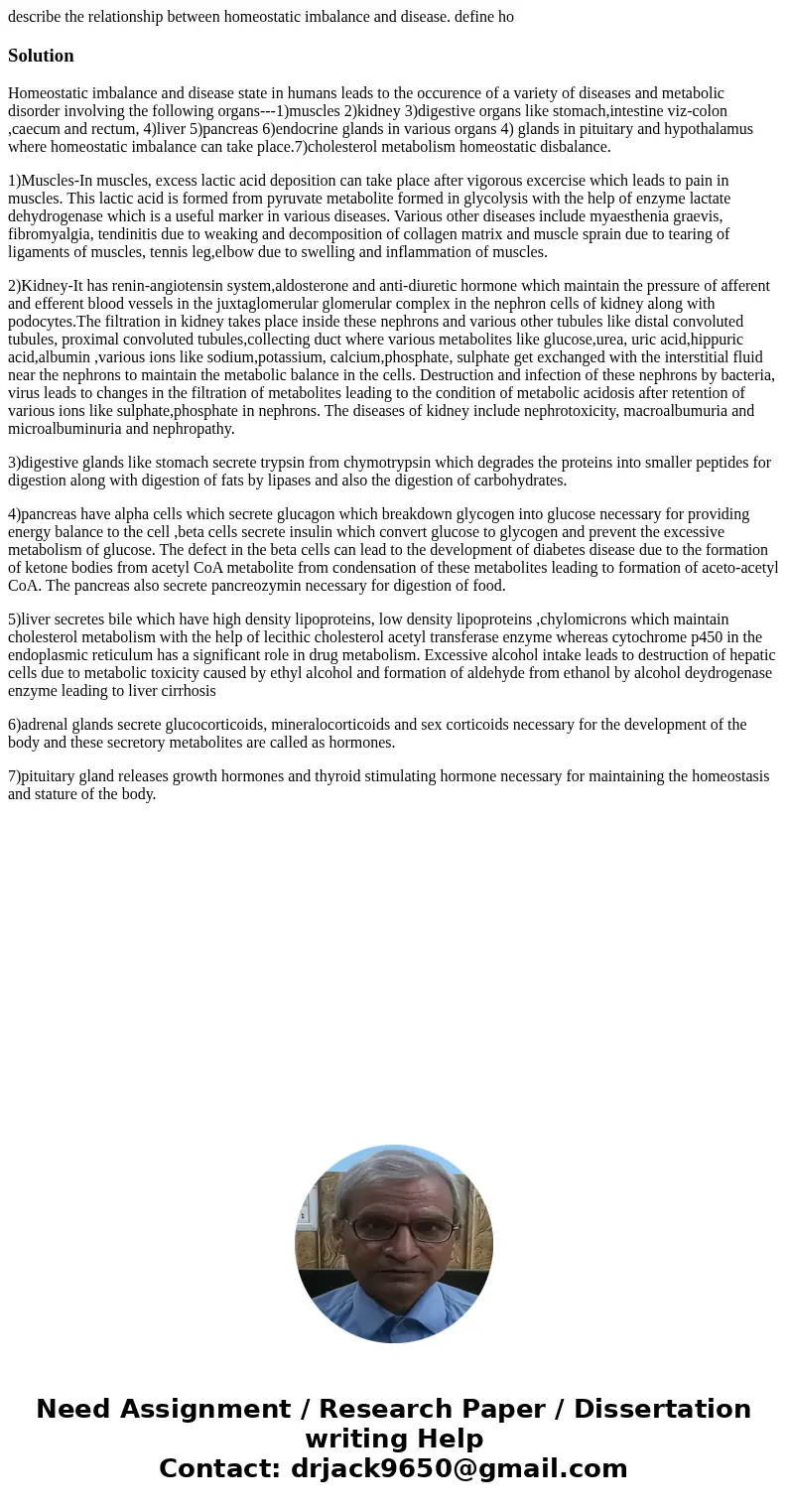describe the relationship between homeostatic imbalance and
describe the relationship between homeostatic imbalance and disease. define ho
Solution
Homeostatic imbalance and disease state in humans leads to the occurence of a variety of diseases and metabolic disorder involving the following organs---1)muscles 2)kidney 3)digestive organs like stomach,intestine viz-colon ,caecum and rectum, 4)liver 5)pancreas 6)endocrine glands in various organs 4) glands in pituitary and hypothalamus where homeostatic imbalance can take place.7)cholesterol metabolism homeostatic disbalance.
1)Muscles-In muscles, excess lactic acid deposition can take place after vigorous excercise which leads to pain in muscles. This lactic acid is formed from pyruvate metabolite formed in glycolysis with the help of enzyme lactate dehydrogenase which is a useful marker in various diseases. Various other diseases include myaesthenia graevis, fibromyalgia, tendinitis due to weaking and decomposition of collagen matrix and muscle sprain due to tearing of ligaments of muscles, tennis leg,elbow due to swelling and inflammation of muscles.
2)Kidney-It has renin-angiotensin system,aldosterone and anti-diuretic hormone which maintain the pressure of afferent and efferent blood vessels in the juxtaglomerular glomerular complex in the nephron cells of kidney along with podocytes.The filtration in kidney takes place inside these nephrons and various other tubules like distal convoluted tubules, proximal convoluted tubules,collecting duct where various metabolites like glucose,urea, uric acid,hippuric acid,albumin ,various ions like sodium,potassium, calcium,phosphate, sulphate get exchanged with the interstitial fluid near the nephrons to maintain the metabolic balance in the cells. Destruction and infection of these nephrons by bacteria, virus leads to changes in the filtration of metabolites leading to the condition of metabolic acidosis after retention of various ions like sulphate,phosphate in nephrons. The diseases of kidney include nephrotoxicity, macroalbumuria and microalbuminuria and nephropathy.
3)digestive glands like stomach secrete trypsin from chymotrypsin which degrades the proteins into smaller peptides for digestion along with digestion of fats by lipases and also the digestion of carbohydrates.
4)pancreas have alpha cells which secrete glucagon which breakdown glycogen into glucose necessary for providing energy balance to the cell ,beta cells secrete insulin which convert glucose to glycogen and prevent the excessive metabolism of glucose. The defect in the beta cells can lead to the development of diabetes disease due to the formation of ketone bodies from acetyl CoA metabolite from condensation of these metabolites leading to formation of aceto-acetyl CoA. The pancreas also secrete pancreozymin necessary for digestion of food.
5)liver secretes bile which have high density lipoproteins, low density lipoproteins ,chylomicrons which maintain cholesterol metabolism with the help of lecithic cholesterol acetyl transferase enzyme whereas cytochrome p450 in the endoplasmic reticulum has a significant role in drug metabolism. Excessive alcohol intake leads to destruction of hepatic cells due to metabolic toxicity caused by ethyl alcohol and formation of aldehyde from ethanol by alcohol deydrogenase enzyme leading to liver cirrhosis
6)adrenal glands secrete glucocorticoids, mineralocorticoids and sex corticoids necessary for the development of the body and these secretory metabolites are called as hormones.
7)pituitary gland releases growth hormones and thyroid stimulating hormone necessary for maintaining the homeostasis and stature of the body.

 Homework Sourse
Homework Sourse